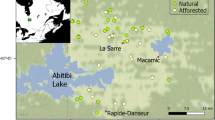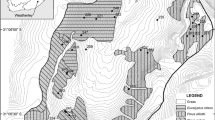Abstract
The rapid transition from miombo woodland and savanna to maize-based agriculture in Southern Africa results in a near universal loss of total system and biomass carbon. Forests and savannas occupy approximately 3.1 million km2 in southern Africa. Two natural ecosystems, a miombo woodland (Zimbabwe) and a broadleafed dry savanna (South Africa), contained 48 and 94 Mg C ha−1, respectively. Clearing of the miombo and establishment of maize-based agriculture on a sandy Alfisol resulted in a decline in total soil organic carbon from 28 to as little as 9 Mg ha−1. This decline is not related to the annual aboveground productivities which, in many cases is greater in the cropping system than in the savanna or forest. Severe declines in total soil organic matter resulting from shifting cultivation were also observed in coastal Mozambique. The CENTURY plant/soil simulation model was used to simulate long-term carbon dynamics a miombo woodland and maize-based cropping system in Marondera, Zimbabwe. The miombo woodland continues to accumulate total system C but shifting cultivation and commercial cultivation of maize result in annual carbon losses of 0.15 and 0.14 Mg ha−1 yr−1. Increases in temperature (2° C) accompanied by 25% increases in photosynthetic efficiency did not effect the decline in total system carbon, however, improved organic matter management within the agroecosystem reduced the losses in total system carbon within the agroecosystem by 57% under the climate change scenario.
Similar content being viewed by others
References
Anderson, J.M. and J.S.I. Ingram: (1989).Tropical Soil Biology and Fertility: A Handbook of Methods. CAB International, Wallingford, UK.
Ayanaba, S.B. Tuckwell and D.S. Jenkinson: 1976,Soil Biol. and Biochem. 8, 519–525.
Ayodele, O.J.: 1986,Biol. Fertil. Soils 2, 519–525.
Bouwman A.F.: 1990, Exchange of Greenhouse Gasses between Terrestrial Ecosystems and the Atmosphere in A.F. Bouwman (ed.)Soils and the Greenhouse Effect, J. Wiley and Sons, pp. 59–127.
Brown S. and A.E. Lugo: 1982,Biotropica 14, 161–187.
Cambardella C.A. and E.T. Elliot: 1992,Soil Sci. Soc. Am. J. 56, 777–783.
Cole, C.V., J. Williams, M. Shaffer and J. Hanson: 1987,Soil Sci. Soc. Am. Spec. Publ. 19, 147–166.
Detwiler, R.P. and C.A.S. Hall: 1988,Science,239, 42–47.
FAO: 1991:FAO Yearbook: Fertilisers 1990, Vol. 40, Food and Agriculture Organisation of the United Nations.
FAO, 1992:FAO Yearbook: Production 1991, Vol. 45, Food and Agriculture Organisation of the United Nations.
FAO-UNESCO: 1977,Soil Map of the World: Africa, UNESCO, 297 pp.
Hall, D.O.: 1989,J. Geographical Soc. 146, 175–181.
Hue, N.V., G. Craddock and F. Adams: 1986,Soil Sci. Soc. Am. J. 50, 28–34.
Jagtap, S.: 1992,The Resource Information System (computer software), IITA.
Ladd, J.N., J.W. Parsons and M. Amato: 1977,Soil Biol. Biochem. 9, 309–325.
Lal, R.: 1986, Soil Surface Management for Intensive Land Use and High Productivity, in: B.A. Steward (ed.)Advances in Soil Science, Springer-Verlag, pp. 2–97.
Martins, P.F., C.C. Cerri, B. Volkoff, E. Andreux and A. Chauvel: 1991,Forest Ecol. Management 38, 273–282.
Nye, P.H. and D.J. Greenland: 1960,The Soil Under Shifting Cultivation, Commonwealth Bureau of Soils, 156 pp.
Oades, J.M.: 1984,Plant and Soil 76, 319–337.
Parton, W.J., D.S. Schimel, C.V. Cole, & D.S. Ojima: 1987,Soil Sci. Soc. Am. J. 51, 1173–1179.
Parton, W.J., B. McKeown, V. Kirchner and D. Ojima: 1992,CENTURY Users Manual, Colorado State University.
Post, W.M. and L.K. Mann: 1990, Changes in Soil Organic Carbon as a Result of Cultivation, in: A.F. Bouwman (ed.)Soils and the Greenhouse Effect, John Wiley and Sons, pp. 401–406.
Post, W.M., T. Peng, W.R. Emmanuel, A.W King, V.H. Dale and D.L. DeAngeils: 1990,American Scientist 78, 310–326.
Resck D.V.S. and J.E. da Silva: 1990,Internat. Cong. Soil Sci. 6, 325–326.
Russell, E,W.: 1973,Soil Conditions and Plant Growth, Longman Group Ltd.
Sanchez P.A., C.A. Palm, L.T. Szott, E. Cuevas and R. Lal: 1989, Organic Input Management in Tropical Agroecosystems, in: D.C. Coleman, J.M. Oades and G. Uehara (eds.)Dynamics of Soil Organic Matter in Tropical Ecosystems, NifTAL Project, pp 125–152.
Stevensen, F.J.: 1982,Humus Chemistry, Genesis, Composition, Reactions. Wiley-Interscience.
Tiessen H. and J.W.B. Steward: 1983,Soil Sci. Soc. Am. J. 47, 509–514
Tukahirwa, E.M.: 1992,Uganda — Environmental and Natural Resource Policy and Law: Issues and Options, Makerere University.
Woomer P. and J.S.I. Ingram,: 1990,The Biology and Fertility of Tropical Soils: TSBF Report 1990, TSBF, pp. 44.
Author information
Authors and Affiliations
Rights and permissions
About this article
Cite this article
Woomer, P.L. The impact of cultivation on carbon fluxes in woody savannas of Southern Africa. Water Air Soil Pollut 70, 403–412 (1993). https://doi.org/10.1007/BF01105011
Issue Date:
DOI: https://doi.org/10.1007/BF01105011




